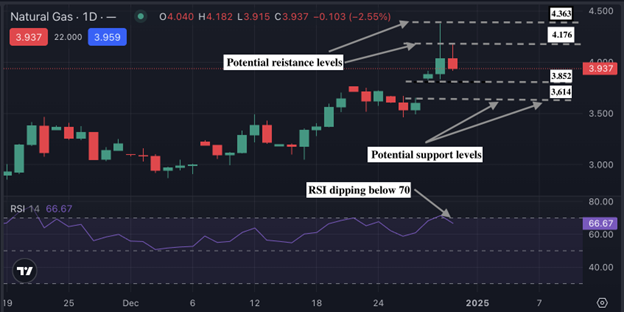As the United States braces for an icy January, natural gas prices are surging, driven by forecasts of colder-than-average temperatures that could stretch from Florida to Maine and the Great Lakes region. On Monday, February futures climbed by 15%, peaking at $4.201 per thousand cubic feet-a 52-week high and the commodity's highest level since early 2023. With winter’s chill tightening its grip, traders and analysts are asking: How high can prices go?
Colder-than-expected weather shakes markets
The latest updates from The Weather Co. and Atmospheric G2 forecast a significant cold snap across the Eastern United States, with the chill expected to peak mid-month. Snow and ice storms are anticipated during the first half of January, further amplifying energy demand for heating. This marks a dramatic shift from the mild conditions seen earlier this winter, catching both consumers and markets off guard.
Meanwhile, the Western U.S. is forecast to remain mild, with the Four Corners region experiencing the most above-average warmth. This regional temperature divergence underscores the complexities of predicting natural gas supply and demand.
Supply-side pressure mounts as the market reacts
As temperatures drop, concerns are growing about potential disruptions to natural gas production. Freeze-offs, where extreme cold halts the flow of natural gas at wellheads, are a particular risk in Appalachia’s Marcellus Shale, a key production area. “Bone-chilling polar vortex weather” could exacerbate these supply constraints, according to John Kilduff, founding partner of Again Capital.
In addition to weather-related risks, demand for liquefied natural gas (LNG) exports remains high. Gulf Coast facilities, including expansions at Cheniere Energy’s Corpus Christi plant and Venture Global LNG’s Plaquemines LNG facility, are ramping up production, further tightening domestic supplies.
The combination of frigid forecasts and supply risks has ignited a buying frenzy among traders. February futures surged as much as 20% earlier in Monday’s session before settling at a 15% gain. Year-to-date, natural gas prices are up 58%, including a 9% increase in just the past week.
This bullish sentiment is driven by the anticipation of heightened demand for heating and power generation, alongside fears of constrained production. Algorithmic trading funds have also shifted from flat to net long positions, reflecting growing confidence in continued price increases.
AccuWeather’s forecasts of a “stormy pattern” in the Eastern U.S. add another layer of complexity. Snow and ice storms could significantly disrupt transportation and infrastructure, further fueling demand for natural gas as a heating source during January’s first half.
Technical outlook: How high can prices go?
The trajectory of natural gas prices hinges on several factors. If the cold spell persists into late January, production challenges and elevated demand could push prices even higher. However, a moderation in temperatures or an unexpected increase in production could temper the rally.
With weather patterns still uncertain for the latter half of the month, the market remains on edge. What’s clear is that the frigid conditions sweeping across the Eastern U.S. are reshaping the natural gas landscape, setting the stage for potentially record-breaking prices.
At the time of writing, prices are hovering around the $3.940 price level with buy pressure seemingly fading as RSI drops below 70. Upward pressure could struggle to breach the $4.176 and $4.363 resistance levels. On the downside, a price slump could find support at the $3.852 and $3.614.
Source: Deriv MT5
The information contained within this article is for educational purposes only and is not intended as financial or investment advice. It is considered accurate and correct at the date of publication. Changes in circumstances after the time of publication may impact the accuracy of the information. The performance figures quoted refer to the past, and past performance is not a guarantee of future performance or a reliable guide to future performance. No representation or warranty is given as to the accuracy or completeness of this information. Do your own research before making any trading decisions.
Recommended Content
Editors’ Picks

Gold corrects from record-high, holds near $3,300 on broad USD weakness
Gold clings to strong daily gains near $3,330 after setting a new record-high near $3,320 earlier in the day. Persistent worries about the escalating US-China trade war and US recession fears continue to weigh on the USD, while boosting the demand for safe-haven Gold ahead of Fed Powell's speech.

EUR/USD holds firm above 1.1350 ahead of Powell speech
EUR/USD is strongly bid above 1.1350 in European trading on Wednesday. The pair draws support from a fresh round of selling in the US Dollar amid persistent fears over US-China trade war and a lack of progress on EU-US trade talks. Fed Chairman Powell is scheduled to deliver a speech later in the day.

GBP/USD trades at multi-month highs above 1.3250 after UK CPI data
GBP/USD builds on six consecutive days of gains and trades at its highest level since early October above 1.2350 as the US Dollar selloff resumes on Wednesday. The data from the UK showed that the annual CPI inflation softened to 2.6% in March from 2.8% in February but had little impact on Pound Sterling.

BoC set to leave interest rate unchanged amid rising inflation and US trade war
All the attention is expected to be on the Bank of Canada this Wednesday as market experts widely anticipate the central bank to maintain its interest rate at 2.75%, halting seven consecutive interest rate cuts.

Future-proofing portfolios: A playbook for tariff and recession risks
It does seem like we will be talking tariffs for a while. And if tariffs stay — in some shape or form — even after negotiations, we’ll likely be talking about recession too. Higher input costs, persistent inflation, and tighter monetary policy are already weighing on global growth.

The Best brokers to trade EUR/USD
SPONSORED Discover the top brokers for trading EUR/USD in 2025. Our list features brokers with competitive spreads, fast execution, and powerful platforms. Whether you're a beginner or an expert, find the right partner to navigate the dynamic Forex market.
